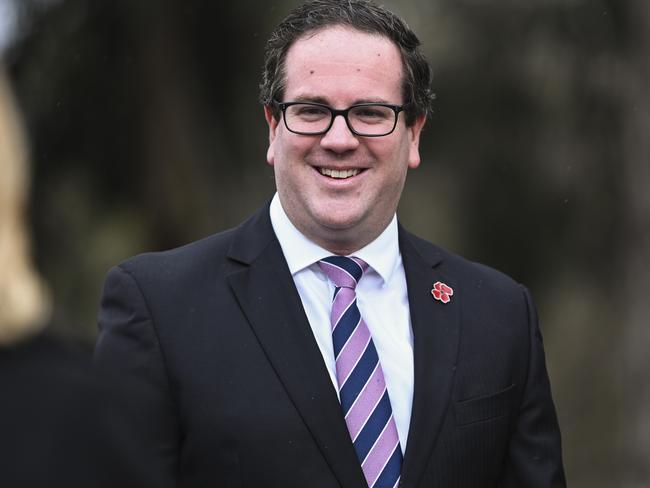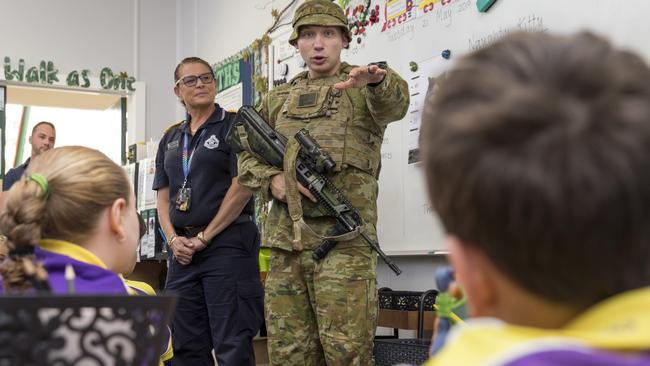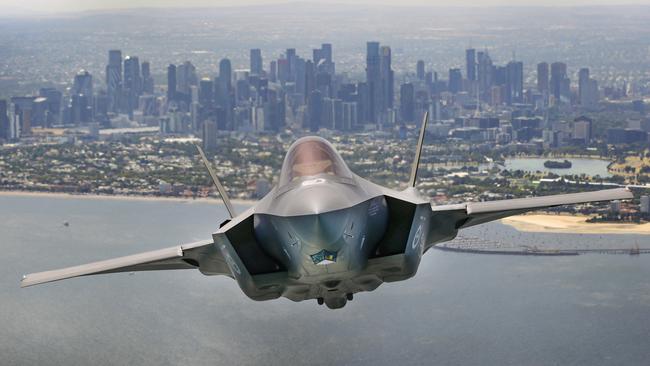ADF to lower fitness and health enlistment to boost recruitment
The Australian Defence Force will lower fitness tests to boost recruitment and target school leavers with a “try before you buy” Reserves program.
National
Don't miss out on the headlines from National. Followed categories will be added to My News.
Exclusive: The Australian Defence Force will lower fitness tests to boost recruitment and target school leavers with a “try before you buy” Reserves program, in a rekindling of a scheme trialled 30 years ago.
The ADF is reviewing various “barriers to service” including tough fitness tests with recognition modern warfare was now just as likely to involve “people in hoodies in basements” than fit frontline fighters.
Currently, men and women joining the Army have to be able to do 45 sit ups, 15 push ups (eight for women) and shuttle runs in an allotted time.

Defence Personnel Minister Matt Keogh confirmed the ADF was now dropping the one-size-fits-all fitness test with benchmarks to be set based on the role likely to be taken. It is hoped the change to “approaches to enlistment”, including basic fitness and health tests, will see an uplift.
Mr Keogh said existing fitness and health requirements had been on the basis of frontline deployment.
“But a lot of those roles never even leave Australia. Some of them, you’re more likely to be wearing a hoodie in a basement doing cyber ops than holding a rifle on the front line,”
he said.
“(So we’re) making sure we’ve got sort of fit for purpose standards. We can accept people with different medical conditions. If they’re doing roles that are only ever going to be Australian based, for example.”

The move comes amid revelations this week that more men and women were quitting the Australian Defence Force (ADF) than were being recruited to meet already lowered targets first set in 2022, and endorsed by Labor last year.
While the target is 80,000, the ADF currently has only about 57,000 personnel.
With current recruitment running at 60 per cent below target, the crisis has been described by Defence as “severe”.
The Federal Government has confirmed Defence had now begun a review into the Reserves and was looking at options to specifically target school leavers in their gap year, as well as recent military veterans who could be enticed to return part-time.
Defence has already thrown numerous incentives at retaining personnel, including $50,000 bonuses for those who recommit to staying on, but it had failed to stem the exodus.

The Defence Strategic Review, released a year ago on Wednesday, determined the Reserves, notably Army, was a pool that could be better engaged for the whole-of-ADF effort.
An internal report on measures to boost Reservist engagement in national defence, to be completed and presented to the government by July, would specifically target tech-savvy school leavers and recent full-time troops who had since quit to take civilian jobs and lifestyles.
Specifically, the review is looking at the Ready Reserve Scheme first created by former Labor leader Bob Hawke in 1991 and dumped by successor John Howard in 1996. The scheme was popular as a try-before-you-buy arrangement, with participants signing up for 12 months full-time intensive commitment before they either transferred to full-time service, or join regular Reservists part-time for a set period of up to four years.

Mr Keogh said the government understood the challenges to recruitment.
“ADF Reserves provide a flexible opportunity for Australians to contribute to our national interest, enhancing our overall ADF workforce,” he said.
“Reserves play a vital role enhancing and supporting Australia’s full time ADF and will play an increasingly important role contributing to our national security and national interest.”
He conceded there had been “teething issues” when recruitment was outsourced to provider Adecco Australia, including a huge blowout in the time taken to enlist individuals.
DEFENCE FORCE RUNS SHORT OF TROOPS
More men and women are marching out of the Australian Defence Force (ADF) than targets to recruit, despite “critical” need to swell the ranks to their biggest levels since the Vietnam War.
And despite being an island nation reliant on maritime defences, our navy has less firepower today than it did 30 years ago, we only have weapon and munition stockpiles to survive just a week of war and there are claims the Defence bureaucracy is at war with itself.
On Wednesday it will be 12 months since the release of the Defence Strategic Review (DSR) that warned our defences were not fit for purpose as the nation faced its most challenging security outlook in 80 years.

Just how we got here spans several governments, but never has the Defence establishment been more at loggerheads with the government over the strategic outlook than now.
And that leaves Australia’s defence mired in delays, indecision and endless reviews.
Last year Defence Minister Richard Marles said he would be receiving a review into the Navy’s surface combat fleet by the time Geelong won the premiership with a government response thereafter made “in pretty short shrift”.
Collingwood won the premiership against the Brisbane Lions and while Marles did receive the report the day before the AFL grand final, a response – and by default the future of the navy – remains blank.
But the continued delay in deciding what to replace the ageing Anzac-class frigates with, and what Australia’s future maritime defence looks like, are the least of the ADF’s issues.
Month on month more troops are quitting than are being recruited, personnel shortages are seeing ships going less out to sea, outdated army armoured vehicles are not fit for conflict and continued delays in signing off new weapons purchases is seeing the local defence manufacture and supply industry in free fall.

Any new top shelf acquisitions are decades away from being realised and missile stockpiles are so depleted, the country’s could not withstand a serious action for more than a week
Despite this and contrary to the military’s own dictum, the collective lack of any sense of urgency is putting the nation at risk; Marles has conceded “we do need to be moving at a faster pace and we will”.
This year Australia was ranked 16 in the top 50 strongest militaries in the world and 13th in military spending with an annual budget of about $53 billion.
But if Australia fell into war tomorrow, could the ADF cope?
“The short answer is no,” former defence and intelligence official Dr Marcus Hellyer, who is now head of research at Strategic Analysis Australia, said.
He said traditionally Australian defence has only ever geared towards preparing to go to wars of choice, but now it was trying to do that as well as the possibility of defending its border sovereignty.

“We can’t even send a small contribution away to wars of choice, like to the Red Sea for the Houthis, can’t send a warship because we either don’t have anything available or they are not equipped to deal with the kind of threats that they would be facing. A couple of years ago we might have been able to but it is getting worse,” Dr Hellyer said.
“I think we are really in a very bad situation. The air force isn’t too bad certainly in its platform but in terms of munitions it is going to run short of munitions very quickly because we have only started to get (long range missiles), navy is an ageing fleet and we are one serious accident away from the Collins (submarine) capability being shelved … the Army is a bit all over the place and it is still not entirely clear what is the role of the army, and if you don’t really know that how do you plan for it?”
In March 2022, then Prime Minister Scott Morrison announced the biggest increase to the ADF since the Vietnam War with a pitch to increase the forces by up to 30 per cent or about 18,500 people to 80,000 by 2040. About 12,500 are specifically to be job matched to the huge capability boost of the AUKUS submarine, missile and drone program.
Labor accepted that but in Defence’s internal tracking they are not making monthly targets, let alone stemming the number quitting.

The overall funded ADF full time strength was pegged at about 62,700 personnel but by the start of the year it fell on both recruitment and retention and now sits at about 57,200. Separation rates are running at 10.2 per cent, a drop from 11 per cent last year. The largest uplift in total force is expected to be about 4000 new personnel recruited between 2023-2025 but few are expecting to get close to that and a new reduced target could be made soon. ADF recruitment agency Adecco Australia is currently just over 40 per cent of achieving its set recruitment targets. Internally, Defence describes the understrength workforce challenges as “significant” and “severe" with more than 6400 leaving last financial year.
Defence Personnel Minister Matt Keogh conceded there were recruitment challenges but said the government has a review into ADF Reserves to optimise the workforce with the outcome to be revealed by the middle of this year.
“After a decade of neglect, we recognise the urgency and significance of this issue. This won’t be fixed overnight. Addressing the issue and attracting and having access to the right skills to grow our ADF workforce will take time,” he said.

Others agree.
“How the ADF is going to solve its recruitment problem I think is the most pressing thing it faces because down the track if we don’t do the recruiting now then our ability to provide rudimentary defences is really compromised,” fellow at the ANU’s Strategic and Defence Studies Centre Dr Matthew Sussex said.
“It’s all very well to buy these shiny systems but you need people to crew and operate them and you need people often skilled in multiple areas to do lots of different jobs.”
Dr Sussex said Defence had long put capability ahead of strategy and with the DSR has been forced to do it the other way around and that had caused issues.
The ageing Anzac-class frigates, the first of which was to be withdrawn from service in 2024-25, is expected to have to fight on for another nine years with no immediate replacement. In 2018 the government signed off on the British variant of the Hunter class frigates but its design has seen numerous issues and the review into Navy’s combat surface fleet future is expected to now suggest instead of nine maybe only six or three be commissioned.

Military bases are only now undergoing urgent upgrades after years of neglect, the ADF is acquiring new long-range missiles and firing systems, army is undergoing one of its most significant role changes in decades from generalist brigades to specialist combat brigades, with relocation of armour and firepower, but while it is pouring money into the MQ-28A Ghost Bat drone program it will not commit to acquiring low-cost attack drones.
“I don’t think there is any question that a determined adversary would easily triumph over Australia if it wanted to invade us but that would be true regardless whether we are well equipped or not,” Dr Sussex said.
“The ADF is simply not big enough so anything we do has to be in partnership with other countries. It’s whether or not we can provide the kind of capabilities they need to put together a package like securing the South China Sea, securing the Straits of Malacca or whether it’s securing our own borders.”
Currently Australia spends 2 per cent of GDP on defence and the figure is expected to increase in the Budget this May possibly to 2.35 GDP but only as projected forward estimates and not today when strategists say urgent funding uplist is required.




